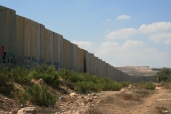Not far from Bethlehem is the little village of Battir.
The village clings to a steep hillside above the narrow and twisting valley through which the Jerusalem to Tel-Aviv railway runs. Along the opposite side of the valley runs the Green Line which is supposed to mark the boundary between Israel and the West Bank. The boundary in this sector has been turned into a national park and is covered with forest. Deep inside the forest lie the ruins of Palestinian villages destroyed shortly after 1948 and which have been erased from most maps.
The village of Battir is known for its cool clear spring waters that have supplied Jerusalem for centuries via a system of aquaducts. During the First Intifada the Jerusalem to Tel-Aviv train was derailed in the valley below the village. [1] Samia still remembers the screams of the men coming from the school house where they were all taken by the army for questioning. Those responsible for the derailment were not identified but all the village men were punished.
Battir is also known as one of the Palestinian seam villages – a village that is trapped between the Green Line and the Wall, an area also known as the “closed zone“. Some 237,000 Palestinians live in this closed zone and face severe restrictions on their freedom of movement. [2]
Closed zone or not, olives must be picked and so it was to Battir, Samia’s family home, that we travelled for the harvest. The taxi ride from Ramallah was uneventful and passed quickly thanks to an interesting commentary. Once the snarl of traffic trying to enter East Jerusalem through Qalandiawas left behind (see Blog 3), we shadowed the Wall skirting the city for about half an hour. Along the way we passed another checkpoint into Jerusalem used by the Israeli settler population. This checkpoint more resembles a toll booth where cars slow down and are visually inspected by border police who make a snap decision whether or not to stop the vehicle. The contrast with Qalandiais striking. Samia explains that some Palestinians do try to enter East Jerusalem through this entry point, but the penalties if caught without the proper permit are harsh. The driver of the vehicle can expect a stiff fine and the confiscation of the car for a period, whilst any person without the corect permit faces up to six years’ imprisonment. Although this great city is only 15 km from Ramallah, Samia laments that she hasn’t been for six years.
On now past the huge settlement of Maaleh Adumim south of Jerusalem, through the Valley of Fire and onwards south with the Judean Desert on our left. Without the Wall, this one and a half hour journey would take about 25-30 minutes.
As we approach Battir Samia and her sister exchange a few anxious words in Arabic – in the three weeks since they were last home the roads entering the village have either disappeared or are now blocked with concrete and barbed wire. Samia doesn’t know how to get into the village of her birth. The taxi pulls to the side of the road as Israeli settlers speed by and the sisters start telephoning friends and family in the village for directions. Several minutes later we proceed on down the road to the new entrance between the coils of barbed wire – “welcome to Battir”beams Samia.
Drama over, we quickly locate the olive grove where we will spend the day and are welcomed by Samia’ s brother, father and aunt – “a true peasant” – Samia proudly proclaims. Within the hour there are about 20 of us, locals and internationals, busy up ladders or hauling sacks to the continuous soothing “plopping” sound made by olives landing on tarpaulins spread beneath the trees.
Around midday the smell of a wood fire fills the air and shortly after the call to prayer from a nearby mosque we sit down under the trees to a delicious lunch of Maqloobeh, which literally translates as “upside down chicken” followed by a siesta in a quiet shady spot. [3]
[1] Intifada means “uprising” in Arabic. There have been two Palestinian intifadas against Israeli occupation, the First Intifada (1987-1993) and the second, or al-Aqsa Intifada (2000 – present).
[2] International Court of Justice, Advisory Opinion on the Legal Consequences of the Construction of a Wall in the Occupied Palestinain Territory (2004) at paragraph 122.
[3] Maqloobeh:-
-
Quarter a chicken and place in a large pot with olive oil.
-
Add several onions, cinnamon sticks and cook until brown.
-
Half boil some potatoes and carrots and add to the pot with pine nuts and herbs.
- Cover the whole thing in rice and add water so as to cover the rice.
- Cook for around 30 minutes and then flip the pot upside down onto a large plate for serving.
(Serves 4) (Mohammed the Arabic teacher’s recipe)







 Posted by ghth
Posted by ghth 






